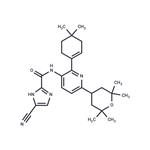4-cyano-N-(2-(4,4-dimethylcyclohex-1-en-1-yl)-6-(2,2,6,6-tetramethyltetrahydro-2H-pyran-4-yl)pyridin-3-yl)- 1H-imidazole-2-carboxamide manufacturers
- Edicotinib
-

- $64.00 / 1mg
-
2025-11-09
- CAS:1142363-52-7
- Min. Order:
- Purity: 99.69%
- Supply Ability: 10g
|
| | 4-cyano-N-(2-(4,4-dimethylcyclohex-1-en-1-yl)-6-(2,2,6,6-tetramethyltetrahydro-2H-pyran-4-yl)pyridin-3-yl)- 1H-imidazole-2-carboxamide Basic information |
| | 4-cyano-N-(2-(4,4-dimethylcyclohex-1-en-1-yl)-6-(2,2,6,6-tetramethyltetrahydro-2H-pyran-4-yl)pyridin-3-yl)- 1H-imidazole-2-carboxamide Chemical Properties |
| density | 1.19±0.1 g/cm3(Predicted) | | storage temp. | Store at -20°C | | solubility | DMSO:23.34(Max Conc. mg/mL);50.56(Max Conc. mM)
DMSO:PBS (pH 7.2) (1:3):0.25(Max Conc. mg/mL);0.54(Max Conc. mM)
DMF:30.0(Max Conc. mg/mL);64.99(Max Conc. mM)
Ethanol:20.0(Max Conc. mg/mL);43.33(Max Conc. mM) | | form | A crystalline solid | | pka | 13.82±0.70(Predicted) | | color | White to off-white | | InChIKey | BNVPFDRNGHMRJS-UHFFFAOYSA-N | | SMILES | C1(C(NC2=CC=C(C3CC(C)(C)OC(C)(C)C3)N=C2C2CCC(C)(C)CC=2)=O)NC(C#N)=CN=1 |
| | 4-cyano-N-(2-(4,4-dimethylcyclohex-1-en-1-yl)-6-(2,2,6,6-tetramethyltetrahydro-2H-pyran-4-yl)pyridin-3-yl)- 1H-imidazole-2-carboxamide Usage And Synthesis |
| Uses | Edicotinib (JNJ-40346527) is a potent, selective, brain penetrant and orally active colony-stimulating factor-1 receptor (CSF-1R) inhibitor with an IC50 of 3.2 nM. Edicotinib exhibits less inhibitory effects on KIT and FLT3 with IC50 values of 20 nM and 190 nM, respectively[1]. Edicotinib limits microglial expansion and attenuates microglial proliferation and neurodegeneration in mice. Edicotinib has the potential for Alzheimer’s disease and rheumatoid arthritis research[1][2]. | | in vivo | Edicotinib (oral gavage; 3, 10, 30 and 100 mg/kg; 5 days) significantly inhibits microglial proliferation in ME7 mice. It diminishes the number of microglia (total CD45+CD11b+ cells) only at the highest dose tested of 100 mg/kg, and JNJ-527 depletes up to 50% of patrolling blood monocytes at every dose tested (CD45+CD11bhighLy6Cintermediate/lowcells) with only a tendency for a reduction in the proportion of inflammatory monocytes (Ly6C high cells) at 100 mg/kg[1].Edicotinib exhibits a good pharmacokinetic/pharmacodynamics (PK/PD) profile, the microglial proliferation data shows an EC50 of 196/ml and 69 ng/g calculated from plasmatic and brain compound concentration, respectively[1].Edicotinib (oral gavage; 30 mg/kg; 33 days) significantly reduces the density of microglia in CA1 of the hippocampus of ME7-prion mice (PU.1+ cells) by up to 30%. And the expression of IL-1β is also reduced,but not other inflammatory cytokines[1]. | Animal Model: | C57BL/6 J (Harlan) mice[1] | | Dosage: | 3, 10, 30 and 100 mg/kg; 5 days | | Administration: | Oral gavage | | Result: | Did not affect microglial numbers when administered under 100 mg/kg. |
| Animal Model: | C57BL/6 J (Harlan) mice[1] | | Dosage: | 30 mg/kg; 33 days | | Administration: | Oral gavage | | Result: | Limited microglial expansion and attenuated behavioural deficits in ME7-prion mice.
|
| | References | [1] Mancuso R, et al. CSF1R?inhibitor?JNJ-40346527?attenuates?microglial?proliferation?and?neurodegeneration?in?P301S?mice.Brain.?2019 Oct 1;142(10):3243-3264. DOI:10.1093/brain/awz241
[2] Genovese MC, et al. Results from a Phase IIA Parallel Group Study of JNJ-40346527, an Oral CSF-1R Inhibitor, in Patients with Active Rheumatoid Arthritis despite Disease-modifying Antirheumatic Drug Therapy.J Rheumatol. 2015 Oct;42(10):1752-60. DOI:10.3899/jrheum.141580 |
| | 4-cyano-N-(2-(4,4-dimethylcyclohex-1-en-1-yl)-6-(2,2,6,6-tetramethyltetrahydro-2H-pyran-4-yl)pyridin-3-yl)- 1H-imidazole-2-carboxamide Preparation Products And Raw materials |
|